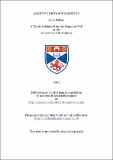Files in this item
Adaptive distance sampling
Item metadata
| dc.contributor.advisor | Buckland, S. T. (Stephen T.) | |
| dc.contributor.advisor | Hammond, Philip S. | |
| dc.contributor.author | Pollard, John | |
| dc.coverage.spatial | 205 p. | en_US |
| dc.date.accessioned | 2018-07-10T11:27:06Z | |
| dc.date.available | 2018-07-10T11:27:06Z | |
| dc.date.issued | 2002 | |
| dc.identifier.uri | https://hdl.handle.net/10023/15176 | |
| dc.description.abstract | We investigate mechanisms to improve efficiency for line and point transect surveys of clustered populations by combining the distance methods with adaptive sampling. In adaptive sampling, survey effort is increased when areas of high animal density are located, thereby increasing the number of observations. We begin by building on existing adaptive sampling techniques, to create both point and line transect adaptive estimators, these are then extended to allow the inclusion of covariates in the detection function estimator. However, the methods are limited, as the total effort required cannot be forecast at the start of a survey, and so a new fixed total effort adaptive approach is developed. A key difference in the new method is that it does not require the calculation of the inclusion probabilities typically used by existing adaptive estimators. The fixed effort method is primarily aimed at line transect sampling, but point transect derivations are also provided. We evaluate the new methodology by computer simulation, and report on surveys of harbour porpoise in the Gulf of Maine, in which the approach was compared with conventional line transect sampling. Line transect simulation results for a clustered population showed up to a 6% improvement in the adaptive density variance estimate over the conventional, whilst when there was no clustering the adaptive estimate was 1% less efficient than the conventional. For the harbour porpoise survey, the adaptive density estimate cvs showed improvements of 8% for individual porpoise density and 14% for school density over the conventional estimates. The primary benefit of the fixed effort method is the potential to improve survey coverage, allowing a survey to complete within a fixed time and effort; an important feature if expensive survey resources are involved, such as an aircraft, crew and observers. | en_US |
| dc.language.iso | en | en_US |
| dc.publisher | University of St Andrews | en |
| dc.subject.lcc | QA276.6P7 | |
| dc.subject.lcsh | Animal populations--Statistical methods | en |
| dc.subject.lcsh | Sampling (Statistics) | en |
| dc.title | Adaptive distance sampling | en_US |
| dc.type | Thesis | en_US |
| dc.type.qualificationlevel | Doctoral | en_US |
| dc.type.qualificationname | PhD Doctor of Philosophy | en_US |
| dc.publisher.institution | The University of St Andrews | en_US |
This item appears in the following Collection(s)
Items in the St Andrews Research Repository are protected by copyright, with all rights reserved, unless otherwise indicated.

